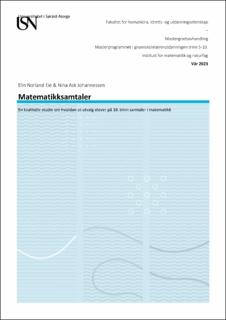| dc.contributor.advisor | Kacerja, Suela | |
| dc.contributor.author | Eie, Elin Norland | |
| dc.contributor.author | Johannessen, Nina Ask | |
| dc.date.accessioned | 2023-09-19T16:41:24Z | |
| dc.date.available | 2023-09-19T16:41:24Z | |
| dc.date.issued | 2023 | |
| dc.identifier | no.usn:wiseflow:6834698:55161454 | |
| dc.identifier.uri | https://hdl.handle.net/11250/3090567 | |
| dc.description.abstract | Denne masteroppgaven omhandler elevers matematikkfaglige samtaler i arbeid med LIST-oppgaver. Denne masteravhandlingen er en kvalitativ studie som omhandler hvordan 10.klasseelever samtaler i matematikk. Studien undersøker samtalekvaliteter i matematikk. De empiriske dataene er innhentet gjennom observasjon av samtaler mellom elever. Hensikten med studien er å få innblikk i hvilke og hvordan, samtalekvaliteter i matematikk kommer til syne, når elever sammen løser LIST-oppgaver. Oppgavens formål er å synliggjøre samtalekvaliteter, og bedre kunne forstå hvordan matematiske samtaler mellom elevene forløper. Dette for å kunne fremme muntlighet i matematikkundervisningen.
Oppgavene elevene ble tildelt var LIST-oppgaver. Det kunne virke til at noen av oppgavene la bedre til rette for samtale enn andre, og vi valgte derfor å forkaste den ene oppgaven inn mot analysen vår. Studiens empiri antyder at oppgavene vi tildeler elevene våre, kan ha betydning for hvordan samtalene til elevene utvikler seg. Hvorvidt oppgavene tilrettelegger for samtale og diskusjon, samt hvor godt elevene evner å starte en samtale og diskusjon, er faktorer som kan indikere i hvilken grad en oppgave er rik.
Våre resultater indikerer at i hvilken grad elevene evner å begi seg ut på en undersøkende tilnærming til oppgavene, har sammenheng med hvorvidt de evner å knytte oppgavene til kontekst. Først når elevene evner å knytte konteksten som er oppgitt i oppgaveteksten, til kontekster fra det virkelige liv, har de en undersøkende tilnærming til oppgaven. Dersom elevene ikke tar hensyn til konteksten i oppgaven, vil deres tilnærming kun være spørrende.
Det resultatet vi anså som mest interessant var forekomsten av den ikke-dialogiske handlingen, fravær av øyekontakt. To av de tre informantparene, løste oppgaver sammen i henholdsvis fem og seks minutter, før de oppsøkte øyekontakt med samtalepartneren sin. Vi anser dette som et interessant funn, da Munkeby (2016) trekker øyekontakt frem som en sentral faktor i utforskende arbeid med andre. | |
| dc.description.abstract | This master thesis concerns students’ mathematical discussions while working on LIST-tasks. The thesis is a qualitative study that investigates how 10th grade students engage in mathematical conversations. The study examines conversation qualities in mathematics. The empirical data has been gathered through observations of conversations that occur between students while solving LIST-tasks. The purpose of the study is to gain insight into which and how conversation qualities appear when the students collaborate on LIST-tasks. The aim of the thesis is to highlight conversation qualities, and to better understand how mathematical conversations among students unfolds, in order to promote verbal communication in mathematics education.
The tasks assigned to the students were LIST-tasks. It appeared that some of the tasks were more conducive to facilitate conversations than others, leading us to exclude one of the given tasks from our analysis. Based on our data collection, it is evident that the task itself, can impact how the conversation between students develops. The extent to witch a given tasks facilitates conversation and discussion, and how well the students are able to start a conversation or discussion, are factors that play a role to how substantial the task is.
According to our results, it appears to be a correalation between students’ capacity to adopt an investigate approach while solving the tasks, and their ability to establish connections between the context of the task, and real-life-context.
When students establish connections between the tasks and context beyond those provided in the task description, they managed to have an investigative approach towards the task. If the contexts is not taken into account, it is interpreted from our results that the tasks are only solved through a questioning approach. The result we considered the most interesting was the occurence of the “non-dialogical” action lack of eye-contact. Two of the three groups, were solving tasks for 5 and 6 minutes respectively, before they started seeking eye-contact with their conversational partners. We found this a particularly interesting result as Munkeby (2016) highlights eyecontact as a central factor in inquiry-based conversations. | |
| dc.language | nob | |
| dc.publisher | University of South-Eastern Norway | |
| dc.title | Matematikksamtaler | |
| dc.type | Master thesis | |
